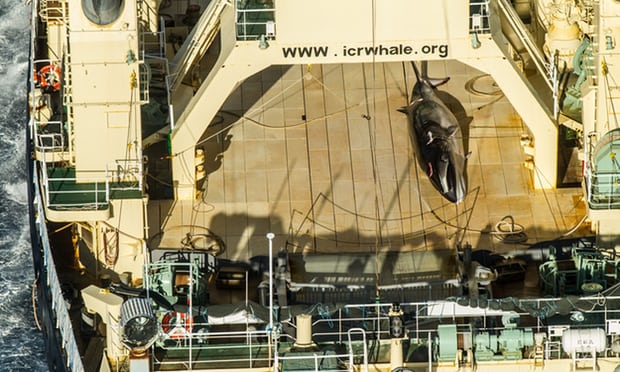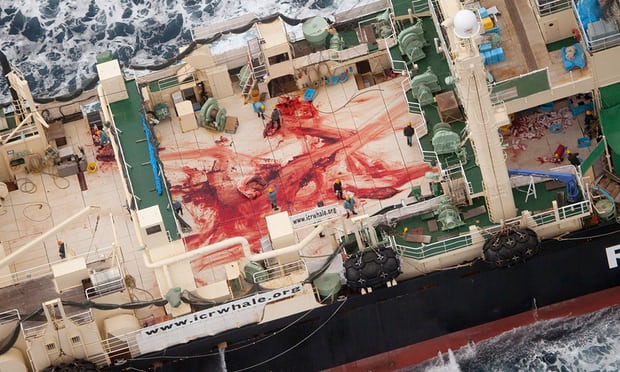Japanese Hunters Kill 120 Pregnant Minke Whales during Summer Months – Report
ANIMAL RIGHTS - VEGETARIANISM, 4 Jun 2018
Conservationists call for end of ‘abhorrent’ whaling programme that Japan, deceitfully, argues is conducted for scientific purposes.

Japan resumed whaling in 2016 under a revamped plan and with reduced quotas.
Photograph: Glenn Lockitch/AFP/Getty Images
30 May 2018 – More than 120 pregnant whales were killed during Japan’s annual “research” hunt in the Southern Ocean last summer, a new report has revealed.
Of the 333 minke whales caught during the controversial 12-week expedition, 181 were female – including 53 immature ones. Figures show that of the 128 mature female whales caught in the hunt, 122 were pregnant.
“Apparent pregnancy rate of sampled animals was high (95.3%) and no lactating animal was observed in this survey,” said a technical report submitted to the International Whaling Commission.
Conservationists seized on the document as further evidence of the “abhorrent” whaling programme, which Japan argues is conducted for scientific purposes.
“The killing of 122 pregnant whales is a shocking statistic and sad indictment on the cruelty of Japan’s whale hunt,” Alexia Wellbelove, a senior program manager at Humane Society International, said in a statement.
“It is further demonstration, if needed, of the truly gruesome and unnecessary nature of whaling operations, especially when non-lethal surveys have been shown to be sufficient for scientific needs.”
In 2014, the international court of justice ordered a temporary halt to the annual slaughter of whales in the Southern Ocean, finding that the Japanese programme known as Jarpa II was not for for scientific purposes.

The blood-stained deck of the Japanese whaling vessel Nisshin Maru in January 2014.
Photograph: Reuters
But Japan resumed whaling in the region two years later under a revamped whaling plan, that included reducing its catch quota to about a third.
“Research effort began 60 minutes after sunrise and ended 60 minutes before sunset, with a maximum 12 hour per day,” said the report, prepared by representatives of the Institute of Cetacean Research – a whale research agency that is associated with Japan’s fisheries ministry. It was co-written with authors from the fisheries processing company Kyodo Senpaku and Tokyo University of Marine Science and Technology.
“One or two minke whales were sampled randomly from each primary sighted school using harpoons with a 30g penthrite grenade,” it said, referring to an explosive material.
“Sampled whales were immediately transported to the research base vessel, where biological measurements and sampling were carried out.”
The report said 11 targeted whales managed to get away before being hit, mainly because they had moved into an area where sea ice was dense.
Wellbelove called on Australia and other anti-whaling countries to send “the strongest possible message to Japan that it should stop its lethal whaling programs”.
__________________________________________________
More: Japan to replace whaling mother ship in sign hunts will go on–
–– Officials say they need a faster ship to evade anti-whaling activists
Go to Original – theguardian.com
DISCLAIMER: The statements, views and opinions expressed in pieces republished here are solely those of the authors and do not necessarily represent those of TMS. In accordance with title 17 U.S.C. section 107, this material is distributed without profit to those who have expressed a prior interest in receiving the included information for research and educational purposes. TMS has no affiliation whatsoever with the originator of this article nor is TMS endorsed or sponsored by the originator. “GO TO ORIGINAL” links are provided as a convenience to our readers and allow for verification of authenticity. However, as originating pages are often updated by their originating host sites, the versions posted may not match the versions our readers view when clicking the “GO TO ORIGINAL” links. This site contains copyrighted material the use of which has not always been specifically authorized by the copyright owner. We are making such material available in our efforts to advance understanding of environmental, political, human rights, economic, democracy, scientific, and social justice issues, etc. We believe this constitutes a ‘fair use’ of any such copyrighted material as provided for in section 107 of the US Copyright Law. In accordance with Title 17 U.S.C. Section 107, the material on this site is distributed without profit to those who have expressed a prior interest in receiving the included information for research and educational purposes. For more information go to: http://www.law.cornell.edu/uscode/17/107.shtml. If you wish to use copyrighted material from this site for purposes of your own that go beyond ‘fair use’, you must obtain permission from the copyright owner.
Read more
Click here to go to the current weekly digest or pick another article:
ANIMAL RIGHTS - VEGETARIANISM: